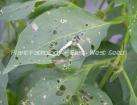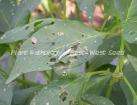| Species: | |
 |
Spodoptera litura (Fabricius) |
| Common name: | |
 |
taro catterpillar |
 |
cluster caterpillar |
 |
common cutworm |
 |
cotton leafworm |
 |
cotton worm |
 |
tobacco caterpillar |
| Damaging stage: | |
 |
Larvae |
| Crops Affected: | |
 |
Cucurbits, solanaceous, legumes, brassicas, cotton, tobacco, onion |
| Characteristic Damage: | |
 |
Newly hatched larvae attack their hosts in cluster and feed gregariously by scraping the leaf surface. |
 |
Larvae move and feed on the other leaves making large irregular holes and may leave only the veins. |
 |
High infestation results to severe defoliation. |
| Management and Control: | |
 |
Monitor the area regularly. |
 |
Hand pick the larvae to reduce the population. |
 |
Remove weeds and volunteer plants that may serve as alternate hosts. |
 |
Cultivate the soil by plowing and harrowing and use plastic mulch to minimize pupation in the soil. |
 |
Plant trap crops like sunflower, taro or castor plants around the area. |
 |
Use of pathogens like the nuclear polyhedrosis virus and entomopathogenic fungi Aspergillus flavus, Beauveria bassiana and Metarhizium anisopliae to reduce cutworm population. |
 |
Apply botanical insecticide like neem extract. |
 |
Apply lambda-Cyhalothrin (BidaⓇ, KarateⓇ, DescarteⓇ), fipronil (e.g. Ascend®, Flipper®), Bacillus thuringiensis subspecies aizawai (Bta) (e.g. Xentari®, Aztron), acephate (e.g. Acetam®, BlackhawkⓇ), fenitrothion (Sumithion 50Ⓡ), deltamethrin (e.g. Decis®, DecideⓇ, ScoutⓇ, Agro DeltametrinⓇ). |
| References: | |
| https://en.wikipedia.org/wiki/Spodoptera_litura | |
| http://www.cabi.org/isc/datasheet/44520 | |
| http://wiki.bugwood.org/Spodoptera_litura | |
To view other diseases, click here.
Need more help? Ask the Doctor.








